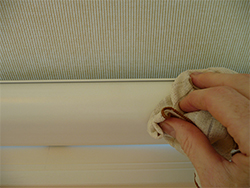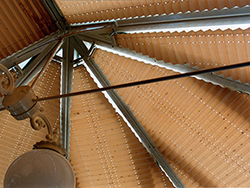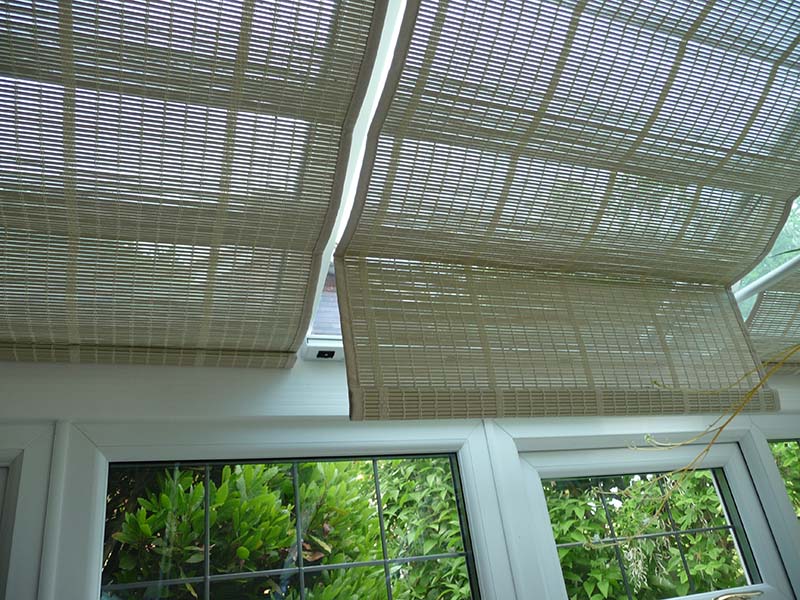Keeping Clean, Staying Healthy
 With regard to blinds in your conservatory side windows, slatted (wood or metal venetian) blinds are the worst culprit as the horizontal slats allow dust to fall & settle on them, requiring regular cleaning to keep them in pristine condition. A damp cloth or specialised cleaning tool is best rather than a feather duster which just removes the dust to become airborne again. Vertical blinds collect little dust, again because they hang in vertical strips, & can be easily washed by rolling up the vanes & putting them inside pillow cases for protection, whilst using the washing machine.
With regard to blinds in your conservatory side windows, slatted (wood or metal venetian) blinds are the worst culprit as the horizontal slats allow dust to fall & settle on them, requiring regular cleaning to keep them in pristine condition. A damp cloth or specialised cleaning tool is best rather than a feather duster which just removes the dust to become airborne again. Vertical blinds collect little dust, again because they hang in vertical strips, & can be easily washed by rolling up the vanes & putting them inside pillow cases for protection, whilst using the washing machine.
Heavy curtains capture dust and are both difficult and expensive to clean. Roman blinds are a better option if you want your window to have a dressed look, but these too collect dust in the folds. Pleated side blinds collect the dust though not as badly as venetians as the folds are less horizontal & the dust is not so visible. Some of the higher quality pleated fabrics can be washed by immersion in the bath, but this is not advisable as the aluminium rails can scratch the bath. Roller blinds are by far the best in this respect as the vertical flat surface does not allow dust to settle, & hence they never require washing, but just an occasional spot clean of the odd dead fly.
Cleaning Your Roof Blinds
Roof blinds are much more difficult to clean than side (window) blinds because:
- The height of the roof & obstructions (furniture & plants) below, making access difficult.
- Support wires get in the way (especially pleated blinds which typically have 50 – 60 in 1 roof compared to roller which have only 1 per blind)
- They collect ten times the amount of dust that side blinds do, due to their angle being pitched rather than vertical.
- Flies always fly up towards the light & heat & hundreds get trapped in that space between the blind & glass, unable to escape they die onto the back of the blind. They then dry up in the heat & disintegrate into “dust” (body parts).
Flies are a particularly horrible problem! The problem is most severe where conservatories are located near farmland with animals, or close to ponds, streams & rivers, lots of trees & shrubs or flowers. City centre locations with little greenery attract the least flies but are not immune to them!
Here are the facts relating to the roof blind choice you make:
Common sense tells you that a pleated, or corrugated, fabric is the worst possible design for catching flies & dust when fitted to a roof. The dead flies cannot simply ”roll” off upon operation as the pleats squeeze together, crushing the dead bodies further & helping the dust/ grime engrain into the fabric.
Whilst the better quality fabrics such as “Topar” backed fabrics (as used by the leading Hunter Douglas companies or their agents) may have a dust repellent treatment, this only helps delay the problem or reduce it slightly. Any backing to a blind will help protect the front of the blind, but dead flies will still show through when viewed from underneath. This is because most pleated fabrics are semi transparent to allow some light through to maintain a vibrant colour.
When the flies are “in season” there can be 500 of them behind 1 set of blinds! Not pleasant to look up at whilst eating your lunch in the conservatory! The only way to clean them is to unclip each blind & vacuum every single pleat! Brushing them is quicker, but unhealthy. Clipping them back up is feasible with the better systems, but not easy. This really should be undertaken by an expert fitter. The serious pleated blinds suppliers will do this for you once per year for around £75 - £100. It should really be done monthly!
Not the best to clean, but not the worst either! The reeds of thin wood strips bound together form a rough, rather than smooth, surface, but the ridges are only a couple of millimetres deep which enables you to “bounce” or agitate the flies to the base of the blind & deal with them here either by unclipping the base rail from the brackets (not easy), or as with the Prestige “Cut Above” system, removing the Pinoleum by means of a velcro type system (really easy & trouble free – see picture).

Sitting under Pinoleum is very much akin to relaxing under a tree, with dappled sunshine filtering through the reeds. This creates a beautiful light effect & also makes the flies virtually impossible to see: you could argue “out of sight is out on mind”, but for those most health conscious amongst us, the Velcro “fly escape” feature is a brilliant way of cleaning, & means you do not have to pay the conservatory blinds supplier to come out & do it for you!
Without question, by far & away the easiest & best roof blind solution from a practical cleaning & maintenance point of view.
The flat format of the blind means that flies simply roll down the back & off under gravity, & this is helped when the blind is rolled down. So essentially they are self cleaning. If cassettes are fitted, these can either be removed say once every 2 years, or the flies sucked out with a vacuum cleaner small hose attachment. On rare occasions, you may need to spot clean a fly mark on the front of the blind & this is best achieved with a clean damp cloth or baby wipe!
Roof roller blinds stay smarter, longer & can still look as new 10 years later, assuming the correct aluminium backed fabric & fitting methods are used.
The continuous & mitred cassettes enhance the appearance further by hiding the brackets & pulleys at facia level, making the blinds appear “built-in” to the conservatory, rather than just planted on like other blind types.
